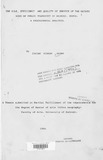| dc.description.abstract | This study is specifically concerned with an intermediate mode of public transport (or para-transit), a phenomenon which is prevalent not only in the form of the matatus in Nairobi but also in other urban centres of Less Developed Countries (LDC ) in slightly different forms: These have emerged basically in response to the generally low standards of living and the high population densities prevailing in most of these urban centres. They play a significant role in providing a much needed service to a wide cross-section of the population. Past and present experience concerning these forms of transport have shown that if they are properly regulated, they ran An even more important role in meeting the mobility needs of the urban population, reducing the need for unprofitable conventional public transport services, increasing the options available for the traveling public, and increasing income and employment generating activities for the low income in urban areas. This study looks at the matatu mode of public transport in Nairobi within the same context. It is based on the notion that there is no single answer to the most appropriate mode of public transport in Nairobi . Instead, due to the limits of available financial resources and the limited executing capability of the ,government and city authorities, the best option available for urban public transport in Nairobi should be that of conservation of the 't' t and their improvement through increment changes. Hence the matatu mode of transport in Nairobi should not be banned in view of its current role. This study attempts 'to measure the matatu system's general role, its efficiency quality of service especially as relates to their generation of employment and incomes for the low income, the proportion of commuters who use them and the reasons why they do so despite the inherent dangers associated with their operations. In do ing this t h e study first identifies the factors which influence the distribution of their services in Nairobi area and notes that there is a str9ng functional relationship between 'the distribution of their services and that of population distribution. The strength of this relationship is measured using correlation and re9ression techniques which are also used to show the nature and strength of the relationship between the distribution of matatu services and other factors such as the distances covered per trip, the profitability levels, and the income levels of the population. The strength of the relationship between the distribution of matatu services and population distribution provides a strong indication of the important role which they play in offering a complimentary service especially in areas of high public transport demand. They have continuously emerged and offer their services mainly in the predominantly densely populated low income zones in Nairobi. They could play an even more important role in increasing the future accessibility and mobility needs of the city's low income residents who are continuously acquiring residence in the suburbs. , The study then looks at some of the factors which influence public transport model choice in Nairobi with a view to identifying the positive quality attributes of the matatus. On the basis of a Stated Preference (SP) study of a sample of commuters it is noted that due to the excessively high demand for public transport services in Nairobi, the commuters tend to choose and use the mode of public transport that is most frequently available. It is because of this that matatus are mostly used. However, a closer analysis of the stated preference using Thurstone's Law of Comparative Judgement Case V procedures reveals that the factors comfort and speed or time taken are also highly valued while there is little concern for factors such as cost, reliability and safety. But it is possible to discern differences in the respondents ranking of the choice factors , , which is attributed to general social-economic factors,such as the level of income, the distances covered per trip, and the level of public transport demand. The factor cost, for example has a relatively higher preference ratings amongst the predominantly low income residents, while the importance of the factor speed or time taken depends on the distances covered per trip. On the basis of these findings, this study makes various suggestions concerning the future of Nairobi's public transport system and the future role of matatus. It notes that some of the positive quality attributes of matatus such as their flexibility in planning for their future role. The past planning responses are also analyzed with a view to showing how they have been implemented and the practical difficulties. | |

